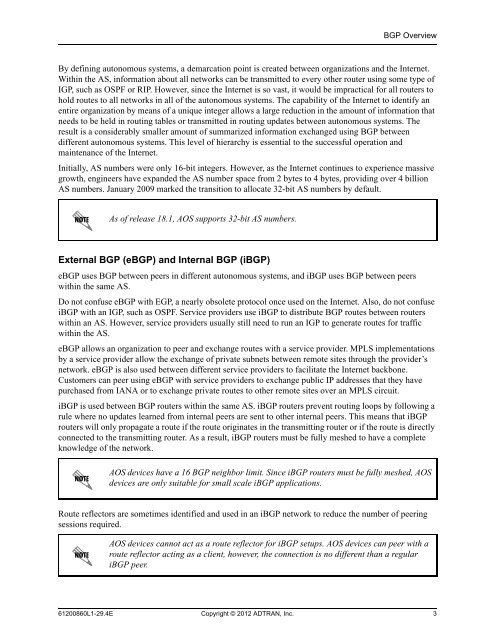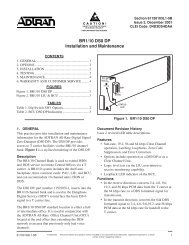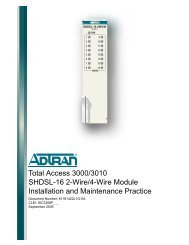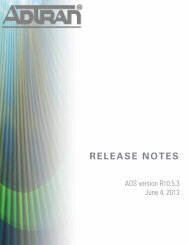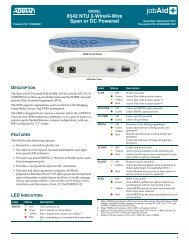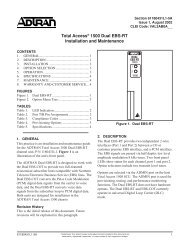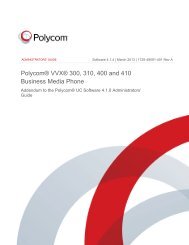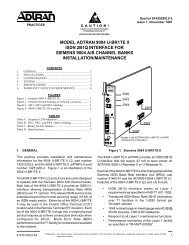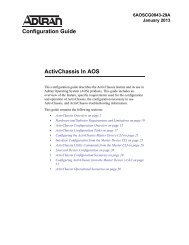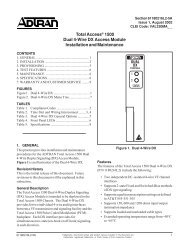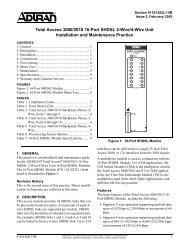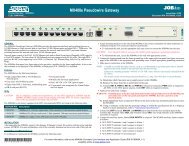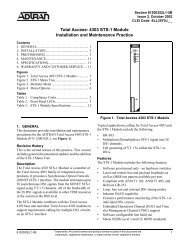View - ADTRAN Support Community
View - ADTRAN Support Community
View - ADTRAN Support Community
Create successful ePaper yourself
Turn your PDF publications into a flip-book with our unique Google optimized e-Paper software.
BGP Overview<br />
By defining autonomous systems, a demarcation point is created between organizations and the Internet.<br />
Within the AS, information about all networks can be transmitted to every other router using some type of<br />
IGP, such as OSPF or RIP. However, since the Internet is so vast, it would be impractical for all routers to<br />
hold routes to all networks in all of the autonomous systems. The capability of the Internet to identify an<br />
entire organization by means of a unique integer allows a large reduction in the amount of information that<br />
needs to be held in routing tables or transmitted in routing updates between autonomous systems. The<br />
result is a considerably smaller amount of summarized information exchanged using BGP between<br />
different autonomous systems. This level of hierarchy is essential to the successful operation and<br />
maintenance of the Internet.<br />
Initially, AS numbers were only 16-bit integers. However, as the Internet continues to experience massive<br />
growth, engineers have expanded the AS number space from 2 bytes to 4 bytes, providing over 4 billion<br />
AS numbers. January 2009 marked the transition to allocate 32-bit AS numbers by default.<br />
As of release 18.1, AOS supports 32-bit AS numbers.<br />
External BGP (eBGP) and Internal BGP (iBGP)<br />
eBGP uses BGP between peers in different autonomous systems, and iBGP uses BGP between peers<br />
within the same AS.<br />
Do not confuse eBGP with EGP, a nearly obsolete protocol once used on the Internet. Also, do not confuse<br />
iBGP with an IGP, such as OSPF. Service providers use iBGP to distribute BGP routes between routers<br />
within an AS. However, service providers usually still need to run an IGP to generate routes for traffic<br />
within the AS.<br />
eBGP allows an organization to peer and exchange routes with a service provider. MPLS implementations<br />
by a service provider allow the exchange of private subnets between remote sites through the provider’s<br />
network. eBGP is also used between different service providers to facilitate the Internet backbone.<br />
Customers can peer using eBGP with service providers to exchange public IP addresses that they have<br />
purchased from IANA or to exchange private routes to other remote sites over an MPLS circuit.<br />
iBGP is used between BGP routers within the same AS. iBGP routers prevent routing loops by following a<br />
rule where no updates learned from internal peers are sent to other internal peers. This means that iBGP<br />
routers will only propagate a route if the route originates in the transmitting router or if the route is directly<br />
connected to the transmitting router. As a result, iBGP routers must be fully meshed to have a complete<br />
knowledge of the network.<br />
AOS devices have a 16 BGP neighbor limit. Since iBGP routers must be fully meshed, AOS<br />
devices are only suitable for small scale iBGP applications.<br />
Route reflectors are sometimes identified and used in an iBGP network to reduce the number of peering<br />
sessions required.<br />
AOS devices cannot act as a route reflector for iBGP setups. AOS devices can peer with a<br />
route reflector acting as a client, however, the connection is no different than a regular<br />
iBGP peer.<br />
61200860L1-29.4E Copyright © 2012 <strong>ADTRAN</strong>, Inc. 3


